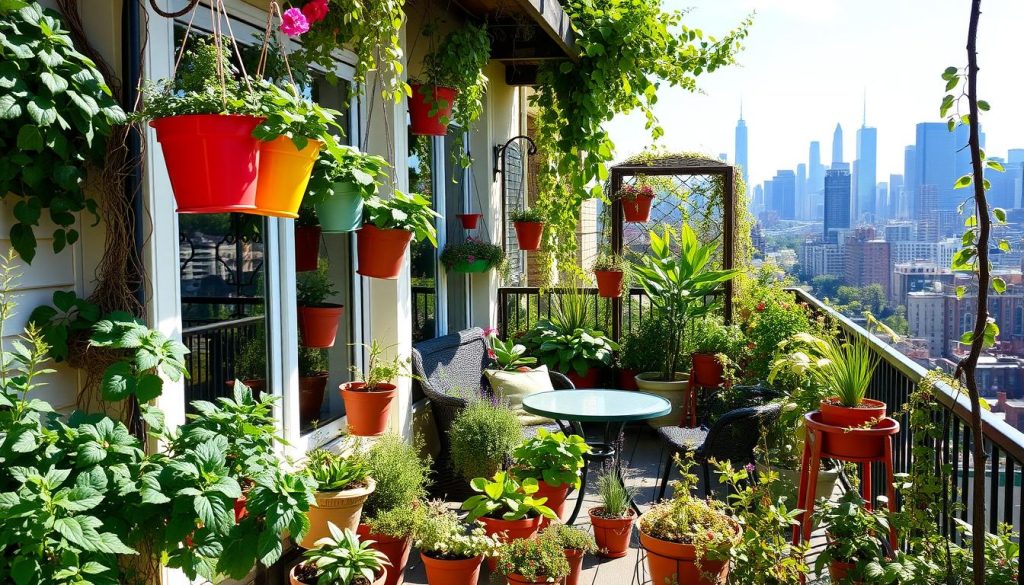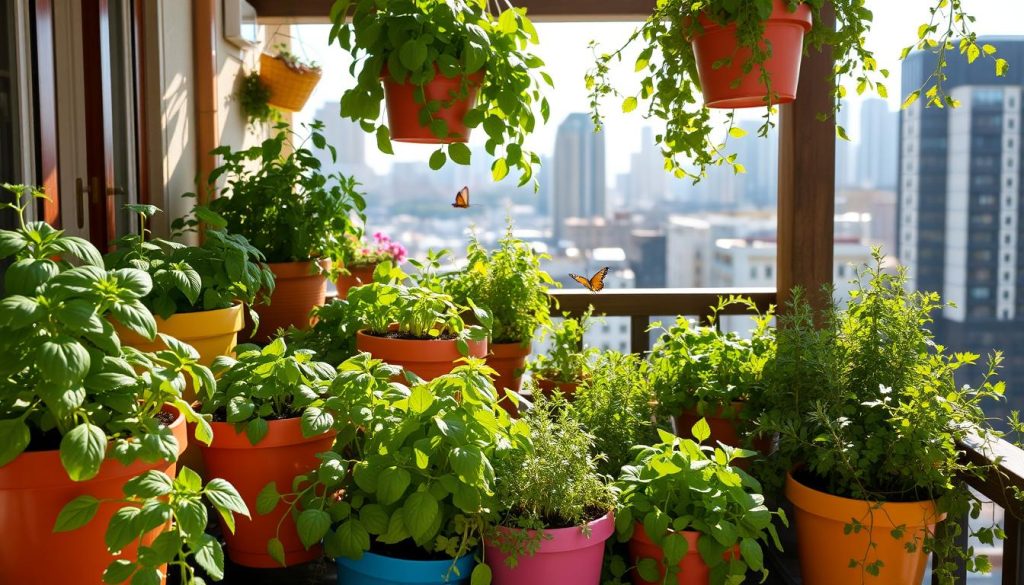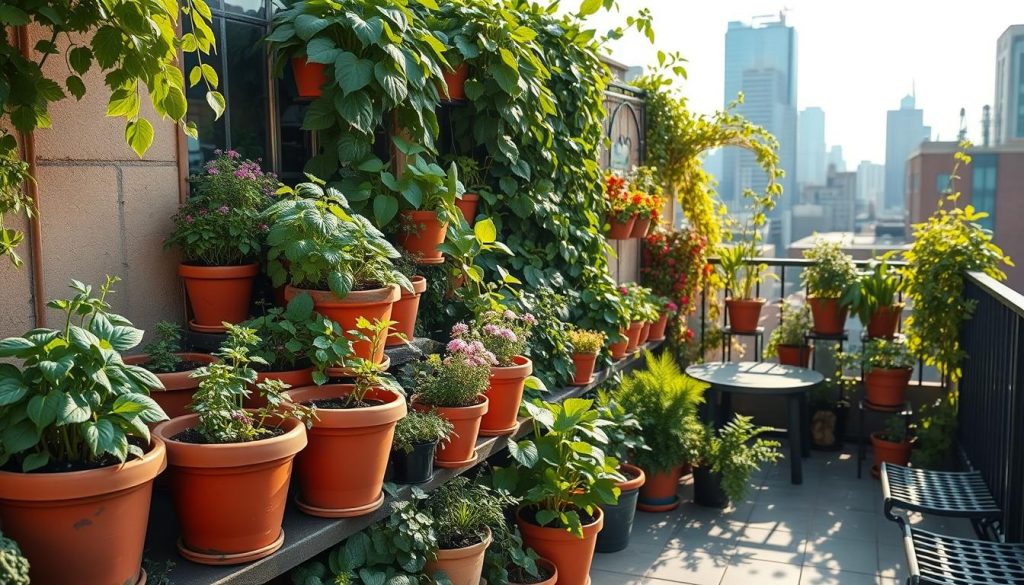Imagine turning your balcony into a lush oasis. You can grow herbs, vegetables, and even small fruit trees. Balcony gardening lets you create a green space in the city, no matter if you’re new or experienced.

Key Takeaways
- Discover the benefits of urban gardening and the key requirements for success
- Learn how to assess your available space and select the right plants for your balcony’s unique conditions
- Explore container selection, soil preparation, and irrigation systems tailored to small-space gardening
- Understand how to manage climate challenges and incorporate space-saving vertical techniques
- Grow a thriving edible garden with herbs, vegetables, and even small fruit trees
- Maintain your balcony garden throughout the seasons with expert care and maintenance tips
- Embrace budget-friendly gardening solutions and create a beautiful, personalized design
Understanding the Fundamentals of Balcony Gardening
Balcony gardening is a great way for city folks to enjoy Container Gardening and Sustainable Living. It can improve air quality, reduce stress, and give you fresh produce. These are just a few of the many benefits of growing plants in the city.
Benefits of Urban Growing
Balcony gardens help clean the air by removing carbon dioxide and adding oxygen. They also offer a peaceful break from city noise, helping you relax and feel better mentally. Plus, you can grow your own herbs and veggies, enjoying fresh flavors right from your balcony.
Key Requirements for Success
To garden on your balcony, you need to know a few important things. These include building rules, weight limits, and how to manage water. Most safety codes say balconies must hold up to 60 pounds per square foot for gardens.
Space Assessment Guidelines
- Check how much space you have on your balcony, looking at its size, shape, and how it faces.
- See how much sunlight your balcony gets, noting any shady spots or sunlit areas.
- Watch the wind and find ways to keep your plants safe from strong breezes.
Learning the basics of balcony gardening lets you make the most of your urban space. You can create a lush, green oasis that brings nature’s beauty and benefits right to your door.
Getting Started: Essential Planning Steps
Starting your urban gardening journey requires careful planning. Whether it’s a small balcony or a rooftop, a solid plan is key. Here are the first steps to start your Container Gardening:
- Evaluate Sunlight Exposure: Check how much sunlight your area gets each day. Most veggies need 6 to 8 hours of sun. For shady spots, choose plants like coleus, ferns, and hostas.
- Choose Appropriate Containers: Pick light containers like plastic or fabric grow bags. They’re easier to move than heavy pots. Make sure they have holes for water to drain.
- Prepare Quality Potting Soil: Use a good potting mix made for containers. Don’t use garden soil, as it can make roots sick.
- Utilize Vertical Space: Use space-saving ideas like hanging baskets and tiered planters. This lets you grow more in less space.
- Start Small: Begin with a few plants to see if you’re ready for more. This helps you learn and grow.
By following these steps, you’ll be ready to start your Container Gardening on your balcony or rooftop. Next, we’ll share more on choosing the right plants and containers.
Light Assessment and Plant Selection
Understanding sunlight on your balcony is key for Balcony Gardening. North- and east-facing balconies get less sun than south- and west-facing ones. Knowing this helps pick Outdoor Living plants that do well in your space’s light.
Understanding Sun Exposure
Figure out how much sun your balcony gets each day. Is it full sun (at least 6 hours of direct sunlight), partial shade, or full shade? This info helps choose the best plants for your Balcony Gardening setup.
Best Plants for Different Light Conditions
- Full Sun: Vegetables, herbs, and sun-loving flowers like marigolds and zinnias.
- Partial Shade: Ferns, coleus, and impatiens.
- Full Shade: Hostas, begonias, and caladiums.
Seasonal Light Changes
The sun’s amount on your balcony changes with the seasons. Plan ahead by picking plants that handle these light changes. This keeps your Outdoor Living space lively all year.
Container Selection and Weight Considerations
Choosing the right containers is key for balcony gardening. Container Gardening lets you grow many plants, herbs, and small veggies in tight spaces. But, you must think about your balcony’s weight limit for a safe and successful garden.
Most balconies are 8 to 12 feet long and 4 to 5 feet wide. Some are even smaller. It’s important to know how much weight your balcony can hold. The weight of soil, plants, containers, and furniture can add up fast. Place heavier pots around the edges to avoid stressing the middle.
For Small Space Gardening, pick lightweight containers like plastic, fiberglass, or fabric grow bags. They’re easy to move and reduce balcony weight. Also, think about self-watering pots to make caring for your garden easier.
Always pick containers with drainage holes to keep your plants healthy. By choosing the right containers, you can make a vibrant balcony garden. It will bring color, life, and versatility to your outdoor area.
Soil Requirements and Drainage Solutions
Balcony gardening needs careful thought about soil quality and drainage. For your Container Gardening to thrive, pick a top-notch potting mix. It should be light and drain well, unlike regular garden soil.
Types of Potting Mix
Choose potting mixes with peat moss, perlite, vermiculite, and compost. These help with drainage, aeration, and keeping nutrients. Don’t use regular topsoil, as it can pack down and cause waterlogging.
Drainage System Setup
- Make sure your containers have enough drainage holes at the bottom.
- Add a layer of gravel, rocks, or coarse materials at the bottom for better drainage.
- Keep an eye on soil moisture and adjust watering to avoid waterlogging.
Using high-quality potting mix and good drainage is key for a successful balcony garden. It ensures your plants get the best conditions to grow well in your urban space.
Watering Systems and Management
Keeping your Urban Garden healthy needs a smart watering plan. Look into drip irrigation and self-watering containers. These help your plants stay hydrated without wasting water.
Drip irrigation and soaker hoses save water in Urban Gardening. They slowly water the soil and roots, cutting down on evaporation and runoff. Drip irrigation has spaced-out holes for even water flow. Soaker hoses have tiny pores for a gentle drip.
- Drip irrigation systems offer a tailored watering solution for long, straight rows.
- Soaker hoses are great for raised beds, trees, shrubs, and perennial beds, providing steady moisture.
Self-watering containers with built-in reservoirs are another good choice. They keep plants watered in hot weather or when you’re busy. To save more water, mulch, add compost, and pick drought-resistant plants.
Good watering habits are key for Urban Gardening success. Check soil moisture and water until water drains from holes. By using efficient watering systems, you can have a green, water-saving Container Garden.
Climate Considerations for Urban Gardens
Balcony Gardening and Urban Gardening face special climate challenges. These challenges affect the health and growth of your plants. Wind and temperature changes are key factors in these small outdoor spaces.
Wind Protection Strategies
Strong winds can harm plants in Balcony and Urban Gardens. They can damage leaves, dry out soil, and even knock over containers. To protect your plants, use trellises, lattices, or other wind barriers.
Placing these barriers wisely can create a safe area for your plants. This helps keep your Outdoor Living space healthy and green.
Temperature Management
Extreme temperatures can stress plants and slow their growth. In hot weather, use umbrellas, awnings, or plants that handle heat to cool things down. For cold areas, pick plants that can handle the cold and insulate your pots.
By tackling these climate issues, you can make your Urban Garden a success. It will thrive even in the city’s unique conditions.
Space-Saving Vertical Gardening Techniques
Urban gardeners with little space find vertical gardening a great solution. It uses wall space, hanging baskets, and tiered planters to grow more plants. Train vining crops like tomatoes and cucumbers to climb up, saving floor space.
Vertical gardening systems range from simple trellises to complex living walls. These systems let you grow a wide variety of plants. From colorful flowers and herbs to compact veggies, you can turn your balcony into a lush oasis.
Vertical Gardening makes small spaces look lush and big. It’s perfect for small gardens and city living. You can choose from living walls, hanging baskets, or tiered planters to make your balcony green and efficient.
When starting Vertical Gardening, think about plant choices, container sizes, and support. Pick plants that do well in balcony conditions. With creativity and planning, you can create a beautiful, productive garden right outside your door.
Growing Edibles in Limited Space
Even with small balconies or patios, you can grow your own food. Choose the right herbs and compact veggies for a thriving garden. This way, you can enjoy fresh produce right in your outdoor space.
Herbs for Balcony Gardens
Herbs are great for city gardeners because they grow well in pots and need little care. Favorites like basil, parsley, and mint add flavor to your meals. They fit in small spaces, from tiny boxes to big pots.
Container Vegetables
For balconies or patios, pick compact veggies like cherry tomatoes, peppers, and leafy greens. Dwarf or dwarf-bush varieties need less room and fit well in larger pots.
Container gardening needs planning. Arrange plants to use space well and try vertical gardening. Use good potting mix and ensure drainage for healthy plants. With creativity and the right plants, you can harvest a lot from your balcony or patio.

Seasonal Plant Care and Maintenance
Gardening on your balcony needs constant care all year. Good Gardening Tips and Sustainable Living practices keep your Outdoor Living space lively.
First, check your plants often. Trim them to keep their shape and promote new growth. Remove dead flowers to keep them blooming and stop them from spreading seeds. In early spring, use a balanced fertilizer to feed your plants.
- Water plants deeply, adjusting how often based on temperature and sunlight. Sunny spots might need water every day in summer.
- Look for pests and diseases, and fix them quickly to stop them from spreading.
- Change your plants with the seasons to keep your balcony garden interesting.
Adjust your care as the seasons change. In spring, refresh the soil and get ready for new growth. Summer means watering and cutting back dead flowers. As fall comes, start cutting back plants and getting ready for winter.
With a regular care plan, your balcony Gardening Tips, Sustainable Living, and Outdoor Living space will stay healthy and lively all year.
Budget-Friendly Gardening Solutions
Creating a vibrant urban garden doesn’t have to empty your wallet. With some creativity and smart planning, you can turn your balcony into a green haven without spending a lot. Let’s look at some ways to garden on a budget and make your outdoor space a dream come true.
DIY Container Ideas
Be creative and turn everyday items into planters. Old buckets, wooden crates, and even tires can become cute and cheap plant homes. These DIY projects save money and add a personal touch to your garden.
Cost-Effective Plant Sources
- Sow your own seeds: Starting plants from seed is much cheaper than buying grown ones.
- Attend local plant sales: Community plant swaps and nursery sales offer affordable plants.
- Divide perennials: Split and replant perennials like daylilies and irises to get new plants for free.
- Propagate from cuttings: Growing new plants from cuttings is a simple way to expand your garden for free.
With a bit of creativity and a focus on budget-friendly options, you can build a thriving urban garden. It will show off your style and sustainable living values, all while sticking to your gardening tips.
Creating a Beautiful Garden Design
Turning your balcony into a garden oasis is rewarding. Choose a variety of plants and add thoughtful design elements. This way, you’ll have a beautiful space that’s also a calm retreat. Whether your balcony is small or large, balance is key.
Begin by picking plants of different heights, shapes, and leaves. Use tall plants like potted shrubs or vines for depth. Then, add lush greens and colorful flowers for a stunning look.
- Group plants by their light and water needs for their best growth.
- Include different textures, like succulent leaves and flower petals.
- Choose colors that match your style and the space’s look.
Don’t forget about design elements that make your garden cozy. Add a seating area, lights, and decorations like planters or a water feature. These add beauty and make your space welcoming.

The charm of a small garden is in showing your style and creating a peaceful spot in the city. With careful design, your balcony can become a place to relax, have fun, and enjoy nature.
Managing Pests and Diseases
As an urban gardener, it’s key to manage pests and diseases. This keeps your garden healthy and full of life. Natural pest control and prevention are the best ways to do this.
Natural Pest Control Methods
Use nature’s power to fight pests in your garden. Companion planting is a smart move. It involves placing certain plants to repel or attract beneficial insects.
For example, marigolds and nasturtiums keep pests away. Dill, mint, and fennel attract insects that eat harmful bugs. This is a natural and effective way to control pests.
Prevention Strategies
Being proactive is vital for a pest-free garden. Clean and disinfect your containers before planting. Sterilize the potting mix and check new plants for pests.
Also, space plants well and ensure good air flow. Remove any infected or damaged leaves quickly. Regular checks and early action are crucial to keep pests under control.
By using natural pest control and prevention, your garden will thrive. It will be free from pests and diseases, making your Urban Gardening a success.
Maximizing Harvest in Small Spaces
Urban vegetable gardening in small spaces is all about getting the most out of little room. By using clever gardening tricks, you can grow a lot even on a tiny balcony or terrace. Focus on growing high-yield veggies like lettuce, tomatoes, and potatoes.
Succession planting means planting new crops to keep the harvest going. This way, you can enjoy fresh veggies all season long. Growing plants that help each other, like tomatoes with basil, can also save space and keep pests away.
Good soil is essential for growing healthy plants in small spaces. Choose quality potting mixes and make sure they drain well. Also, watch how much water your plants need, especially when they’re growing fast.